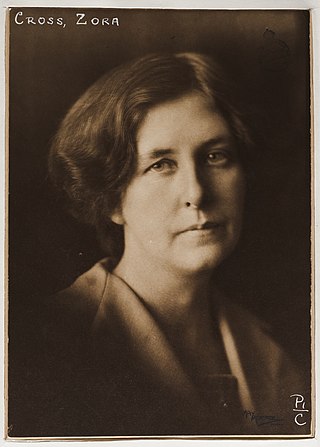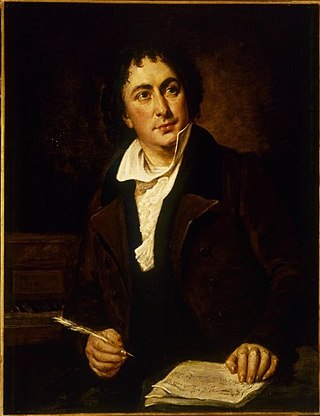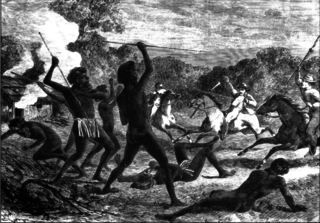
Inverell is a large town in northern New South Wales, Australia, situated on the Macintyre River, close to the Queensland border. It is also the centre of Inverell Shire. Inverell is located on the Gwydir Highway on the western slopes of the Northern Tablelands. It has a temperate climate. In the 2021 census, the population of Inverell was 12,057 and the Inverell Shire population was 17,853.

Gundagai is a town in New South Wales, Australia. Although a small town, Gundagai is a popular topic for writers and has become a representative icon of a typical Australian country town. Located along the Murrumbidgee River and Muniong, Honeysuckle, Kimo, Mooney Mooney, Murrumbidgee and Tumut mountain ranges, Gundagai is 390 kilometres (240 mi) south-west of Sydney. Until 2016, Gundagai was the administrative centre of Gundagai Shire local government area. In the 2021 census, the population of Gundagai was 2,057.

Zora Bernice May Cross was an Australian poet, best-selling novelist and journalist.

The Myall Creek massacre was the killing of at least thirty unarmed Indigenous Australians by twelve colonists on 10 June 1838 at the Myall Creek near the Gwydir River, in northern New South Wales. After two trials, seven of the twelve colonists were found guilty of murder and sentenced to execution by hanging. The trials and guilty verdict sparked extreme controversy within New South Wales settler society. These are among the few successful prosecutions known where Australian settlers were held accountable for massacring Aboriginals. The leader of the perpetrators, free settler John Henry Fleming, evaded arrest and was never tried. Four men were never retried on additional charges following their acquittal in the first trial.

Sir George Gipps was the Governor of the British Colony of New South Wales for eight years, between 1838 and 1846. His governorship oversaw a tumultuous period where the rights to land were bitterly contested in a three way struggle between the colonial government, Aboriginal people and wealthy graziers known as squatters. The management of other major issues such as the end of convict transportation, large immigration programs and the introduction of majority elected representation also featured strongly during his tenure. Gipps is regarded as having brought a high moral and intellectual standard to the position of governor, but was ultimately defeated in his aims by the increasing power and avarice of the squatters.

Sir William à Beckett was a British barrister and the first Chief Justice of the Supreme Court of Victoria.

Isaac Nathan was an English composer, musicologist, journalist and self-publicist, who has been called the "father of Australian music". "Known as the Father of Australian Music, Nathan also assisted the careers of numerous colonial musicians during his twenty year residence in Australia" "Nathan's best known for the success of his Hebrew Melodies (1815-1840) in London. However, he made significant contributions as a singing teacher and music historian during his time at St James Palace and as a composer of opera in the Royal Theatres (1823-1833). After emigrating to Australia in 1840, Nathan wrote Australia's first opera's and Australia's first contemporary song cycle which entangled fragments of Aboriginal songlines with european musical traditions. Nathan tailored compositions to the unique individual singing needs of his students and community choirs while using the Neapolitan bel canto pedagogical tradition that he inherited in London. Nathan's best students were Mary Anne Lucy Chambers (1834-1894) "The Australian Nightingale" and Dame Marie Carandini, both of whom became the first teachers of Dame Nellie Melba.

John Hubert Plunkett was Attorney-General of New South Wales, an appointed member of the Legislative Council 1836–41, 1843–56, 1857–58 and 1861–69. He was also elected as a member of the Legislative Assembly 1856–60. He is best known for the prosecution of the colonists who brutally murdered 28 Aboriginals in the Myall Creek Massacre of 1838, seven of whom were convicted and hanged.
The following lists events that happened during 1838 in Australia.
The white woman of Gippsland, or the captive woman of Gippsland, was supposedly a European woman rumoured to have been held against her will by Aboriginal Gunaikurnai people in the Gippsland region of Australia in the 1840s. Her supposed plight excited searches and much speculation at the time, though nothing to put her existence beyond the level of rumour was ever found.

Sir William Westbrooke Burton was a judge and President of the Legislative Council, New South Wales, Australia. He was presiding judge in the second trial of the Myall Creek massacre. The trial was the only case in Australian history in which white settlers were successfully prosecuted for massacring Aboriginals.
Nationality words link to articles with information on the nation's poetry or literature.

Henry Dangar (1796–1861) was a surveyor and explorer of Australia in the early period of British colonisation. Despite an upheld challenge to some of his early land claims, he received huge land grants.
The Border Police of New South Wales was a frontier policing body introduced by the colonial government of New South Wales with the passing of the Crown Lands Unauthorised Occupation Act 1839.

Myall Creek Massacre and Memorial Site is the heritage-listed site of and memorial for the victims of the Myall Creek massacre at Bingara Delungra Road, Myall Creek, Gwydir Shire, New South Wales, Australia. The memorial, which was unveiled in 2000, was added to the Australian National Heritage List on 7 June 2008 and the New South Wales State Heritage Register on 12 November 2010.
Eliza Hamilton Dunlop was an Irish–Australian poet and songwriter, known for composing the poem "The Aboriginal Mother" among others. She was born in County Armagh, Ireland, and was raised by her grandmother and a guardian, after her father travelled to India and her mother died. Later, she travelled to India to visit her father and discovered that she had two Indian half-sisters. Her writing career began in Ireland while she was still a child. After moving to Australia, her works were published in newspapers there, some set to music by Isaac Nathan after he arrived in Australia in 1841.
Criminal activity in New South Wales, Australia is combated by the New South Wales Police Force and the New South Wales court system, while statistics about crime are managed by the Bureau of Crime Statistics and Research. Modern Australian states and cities, including New South Wales, have some of the lowest crime rates recorded globally with Australia ranked the 13th safest nation and Sydney ranked the 5th safest city globally. As of September 2018 the City of Penrith (475.7) and City of Blacktown (495.1). Rural areas have comparatively high crime rates per 100,000 with rural shires such as Walgett Shire (1350.3) and Moree Plains Shire (1236.2) having some of the highest violent crime rates in the state. The overall NSW crime rate has been in steady decline for many years.
Myall Creek is a rural locality split between the local government areas of Inverell Shire and the Gwydir Shire in New South Wales, Australia. In the 2021 census, Myall Creek had a population of 27.
George James MacDonald was a Commissioner of Crown Lands in the British colony of New South Wales where he founded both the city of Armidale and the town of Balranald. He is mostly remembered for his role in leading a contingent of Border Police troopers in a large massacre of Indigenous Australians in the Clarence River region. MacDonald was also considered a talented linguist and writer, producing several published works of poetry and prose reflecting on his experiences in Australia.










